Aptos and Sui: Where is the next generation of Blockchain in the future 2022 – 20??
Aptos and Sui: Where is the next generation of Blockchain in the future 2022 – 20??
Aptos and Sui can become the two leading blockchains in the future. After Solana, new generation Layer 1 projects have recently begun to appear, bringing many expectations to realize the “impossible trio of blockchain”. Let’s learn about Aptos and Sui, projects expected to rival Solana or Ethereum.
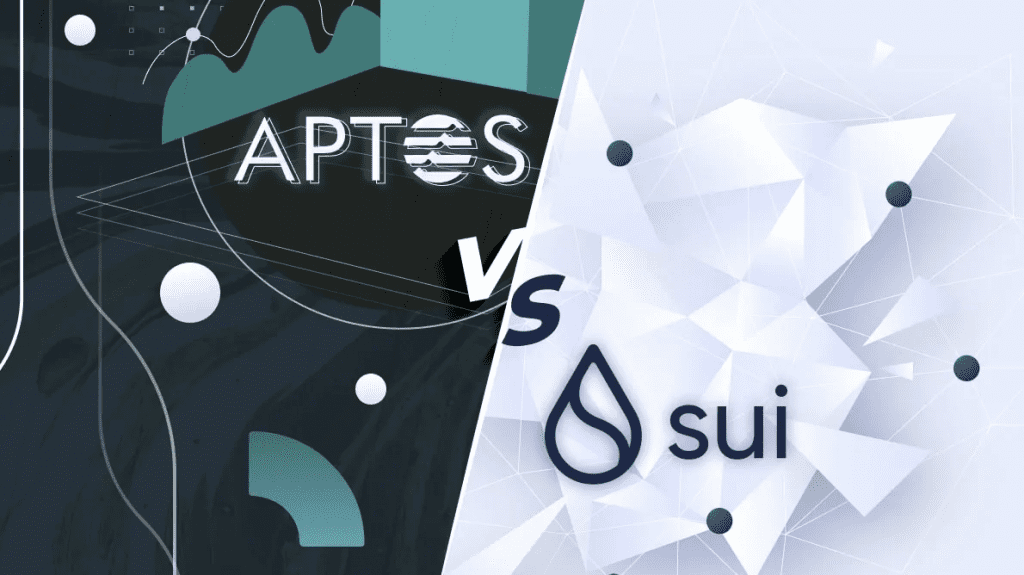
Current Layer 1 context
Since the beginning of 2022, Layer 1 blockchains have shown signs of “uncertainty” in turn:
- Ethereum “older brother” after the announcement of ETH 2.0 met with controversy broke out from two sides, one side supported the Proof of Stake school, and the other maintained the stance on Proof of Work.
- Solana encountered a hacked wallet related to a Slope wallet with a scale of up to 8000 people and unspecified damage.
- Tron currently exists mainly based on the breath of USDD.
- Fantom no longer attracts users after Andre Cronje left.
- Cardano has not yet formed a Defi ecosystem while having been around since 2017…
In the context that L1 chains are competing very fiercely, non-EVM chains are somewhat weak, new projects have begun to appear, and two names that are attracting the attention of the whole market, Aptos and Sui will be in charge. The mission is to become a rival to Solana and beyond Ethereum.
Aptos vs Sui Comparison: Two New Generation Blockchains
What are Aptos and Sui?
Both Aptos and Sui are new generation L1 blockchains, developed with the ultimate goal of creating a comprehensive, decentralized, high-transaction, and low-latency blockchain that brings Web3 closer. with general users.
Aptos and Sui are two project branches developed from Facebook’s Diem blockchain (present-day Meta). After Diem blockchain co-founder David Marcus left Facebook, the project was later abandoned. The team working on the Diem project then gradually separated to develop other projects, in which Aptos and Sui were the two most noticed projects.
These are also two projects using the Move programming language, a programming language researched and developed for Diem.
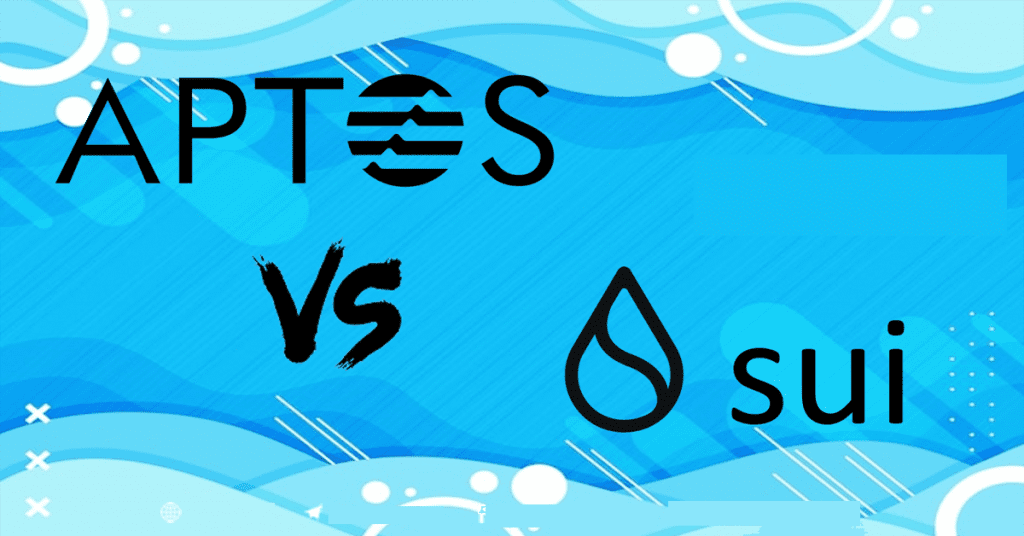
Team & Formation
Aptos
Behind the Aptos, project is Aptos Labs, founded by two co-founders Mo Shaikh (CEO) and Avery Ching (CTO). The two, along with several other team members who worked together at Meta on the Diem blockchain project, later founded Aptos Labs together to further develop the technology they built for Diem.
Other members of Aptos Labs are also people with extensive professional experience, having worked at large companies in the blockchain industry as well as in traditional finance such as KPMG, Blackrock, Robinhood, Huobi, JP Morgan…
Recently Aptos has also attracted a few members from Solana Labs, the most prominent of which is Austin Virts, former Head of Marketing at Solana.
Aptos is still quite new, the development roadmap is quite stable. At the beginning of March 2022, the devnet will be launched, the second quarter of 2022 will launch the incentive testnet, it is expected that the mainnet will be released in Q3/2022 and the fourth quarter of 2022 will develop more networks with new updates.
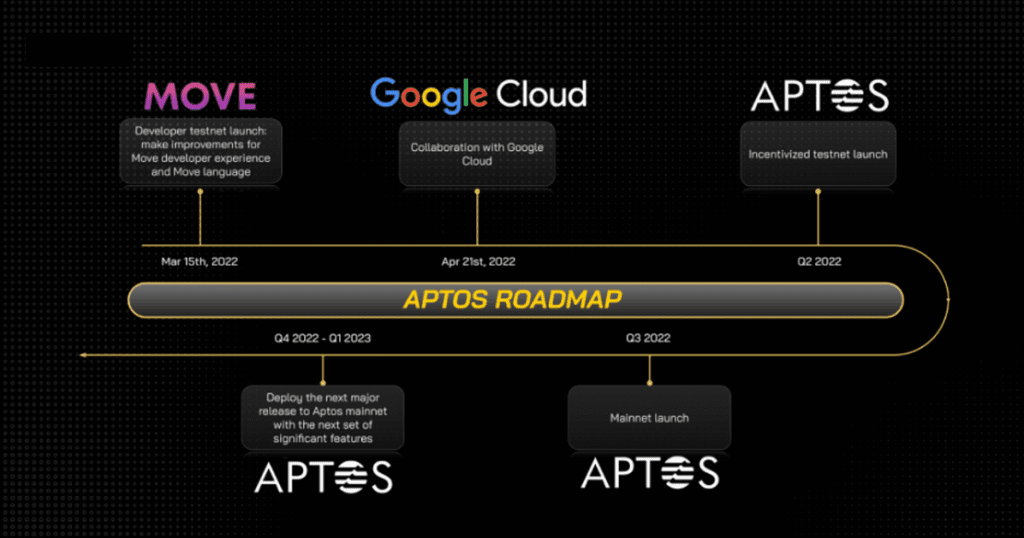
Sui
The team that built the Sui blockchain is Mysten Labs. Mysten Labs was co-founded by members Evan Cheng (CEO), Sam Blackshear (CTO), Adeniyi Abiodun (CPO), and George Danezis (Chief Scientist).
Which, Evan Cheng is the R&D Leader of Novi Financial (Meta’s crypto product building branch), Adeniyi Abiodun is the Product Leader of Novi Financial… and many other members hold key roles in Meta’s blockchain branch.

Sui launched a bit slower than Aptos. The new Sui will be introduced to the community in March 2022, the devnet will be launched in May 2022 and it is expected that it will not be possible to complete and launch the mainnet until the end of 2022.
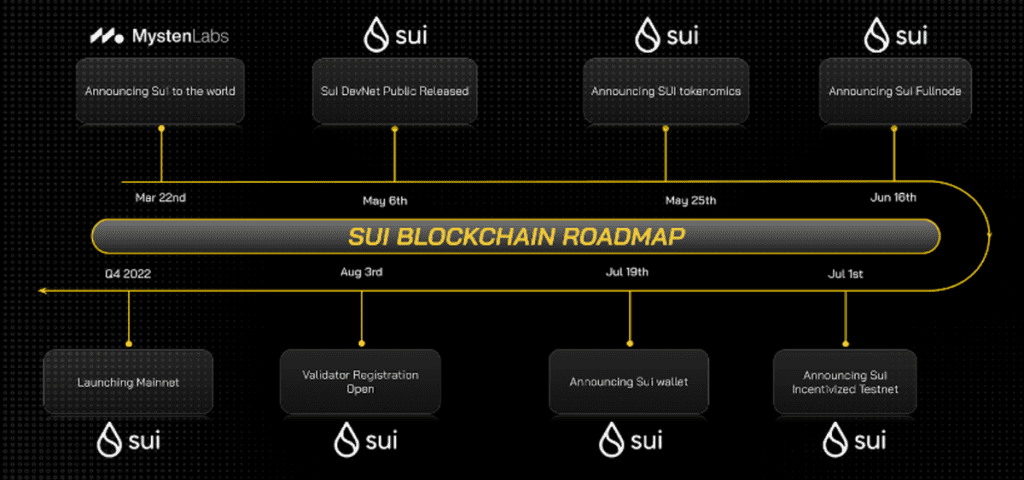
It can be seen that both projects have talented teams, who are both experienced and have worked in large companies. In particular, Mysten Labs has more members who were previously key members of Meta (Facebook) engineering and product development, while Aptos Labs is somewhat more diverse in terms of people.
Technology
Programming language
Both Aptos and Sui use the Move programming language used from the Diem project. Move is Solana’s Rust-based programming language, Move focuses on memory safety, can provide transparency for immutable values , and prevents memory data leaks.
Move was developed by the Diem team in 2019 – 2020, at that time NFT had not become popular, and this new programming language was not optimized for NFT or GameFi genres. Formed in late 2021 or early 2022, Sui has improved and added a bit, creating his version of Sui Move.
This mechanism is called the Object-centric model, Sui Move divides property types into objects of which there are 3 main types:
- Owned object: Owned by a specific owner and can only be modified by that owner.
- Shared object: Mutable, has no specific owner, and can be included in the transaction of different parties without any permission.
- Read-only object: Has no exclusive owner, cannot be changed by anyone after being published and can be used in transactions by all users.
The division of assets into many types helps Sui to optimize processing speed, transaction time for NFTs, game items, etc. This is in line with the mainstream NFT/Game development orientation on Sui.
Consensus Mechanism
Both Aptos and Sui use a Proof of Stake consensus mechanism with validators staking native tokens and running the network. However, the two projects have different consensus algorithms behind them.
Aptos uses BlockSTM technology and the Byzantine Fault Tolerance (BFT) consensus protocol.
- Byzantine Fault Tolerance (BFT) Consensus Protocol: Analyzes on-chain states and automatically updates validators to adjust validators that do not meet conditions without human intervention, only maintaining network decentralization… The BFT system can continue to function even if some nodes fail.
- BlockSTM: A consensus mechanism developed from Hotstuff, a parallel transaction execution engine for smart contracts that can increase throughput for Aptos.
Sui uses Narhal & Tusk consensus algorithm and uses a DAG-based (directed acyclic graph) mempool to separate data transmission from transaction consensus, and parallel transaction processing. The asynchronous protocol means it can withstand denial of service (DoS) attacks.
The parallel naming of the consensus mechanism also reveals two different tasks:
- Narwhal: Ensuring data availability when submitted leads to consensus.
- Tusk: Specifies a specific order of data.
This is done in a layered 2-module model, so Narwhal can also be used in conjunction with other external cryptocurrencies like HotStuff, BFT, or Tendermint… Narwhal has also been used by other blockchains such as Celo, and Sommelier.
In terms of technology, Sui is considered a bit better by the community due to having a more optimal programming language and a somewhat more secure consensus mechanism. Both projects scale to parallel transaction processing, maximizing network capacity.
Tokenomics
Aptos
Aptos has not officially announced the token nor has information about the token, the economic model of the ecosystem. But it is also certain that there will be APTOS tokens used for gas fees and network security.
Sui
On the Sui side, information about the SUI token is revealed in more detail. Accordingly, SUI – the network’s native coin will have the following main uses:
- Gas fees: all network operations on the platform require gas fees. Gas fees are rewarded to those who participate in the Proof of Stake mechanism. It can also be used to prevent spam and denial of service attacks.
- Storage Fund: To pay future validators to bear on-chain data storage costs, Sui’s storage is used to distribute stake rewards to validators over time.
- Proof-of-stake Mechanism: Used to select, incentivize and reward platform operators, also known as validators and delegators.
- On-chain voting: To vote on decisions on governance and protocol upgrades.
Fundraising
Aptos
Recently, Aptos has made a big splash when it comes to raising capital from big investors right in the gloomy market period. Up to now, Aptos has completed 2 rounds of Seed Round and Series A funding with a total amount of 350 million USD.
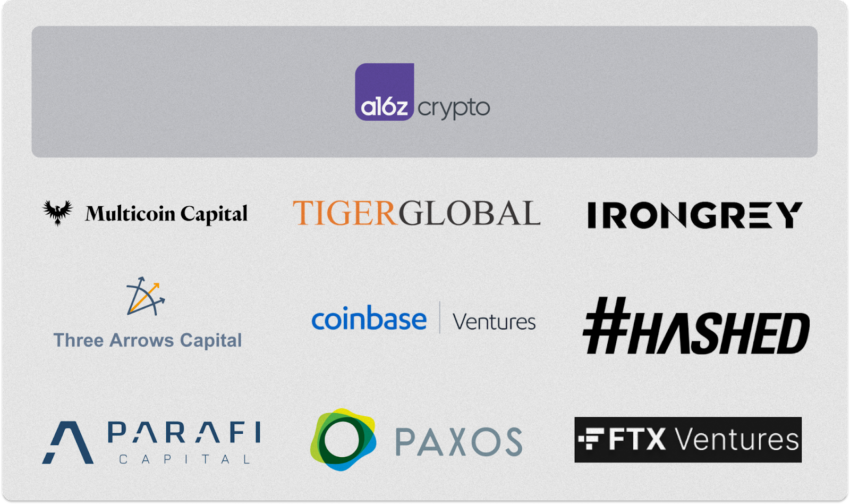
Seed Round:
- Publication date: March 15, 2022
- Amount raised: 200 million USD
- Main investor: Andreessen Horowitz (a16z)
- Other investors: Multicoin Capital, Three Arrows Capital (not yet collapsed), Hashed, Tiger Global, FTX Ventures, Coinbase Ventures, Parafi Capital…
- Valuation: Over 1 billion USD
Series A:
- Announcement date: July 25, 2022
- Amount raised: 150 million USD
- Main Investor: FTX Ventures and Jump Crypto
- Other investors: Apollo, Griffin Gaming Partners, Franklin Templeton, Circle Ventures, Superscrypt, and continued support of a16z, Multicoin Capital…
- Valuation: $2 billion
Sui
On Sui’s side, this project is also receiving the attention of many large investment funds in the market. Sui completed the Series A and Series B funding rounds.

Series A:
- Announcement date: 6/12/2021
- Amount raised: 36 million USD
- Main investor: a16z
- Other investors: NFX, Scribble Ventures, Redpoint, Lightspeed Venture Partners, Electric Capital, Samsung NEXT, Slow Ventures, Standard Crypto, Coinbase Ventures…
Series B:
- Announcement date: September 8, 2022
- Amount raised: 300 million USD
- Series B funding round was led by FTX Ventures and a series of other large investment funds such as a16z, Jump Crypto, Apollo, Binance Labs, Franklin Templeton, Coinbase Ventures, Circle Ventures, Lightspeed Venture Partners, Sino Global, Dentsu Ventures, Greenoaks Capital, O’Leary Ventures,…
Ecosystem
Aptos
In general, the Aptos ecosystem has had a certain completion in terms of projects in different areas, the DeFi ecosystem is also quite complete even though it is only at the devnet stage, the projects span the arrays from AMM, Yield Optimizer, Derivative, Aggregator….
In addition to the above projects, there are projects Tsunami Exchange, Laminar, Mariana Exchange, AptoSwap, Umi Protocol, and Econia in the DEX array that have confirmed to build on Aptos but have not yet launched products.
It can be seen that even in important sectors such as AMM or wallet, NFT Marketplace has also appeared the competition of many different projects, which will create motivation for projects to develop further. Although the projects are still new, this is a positive sign for the entire ecosystem.
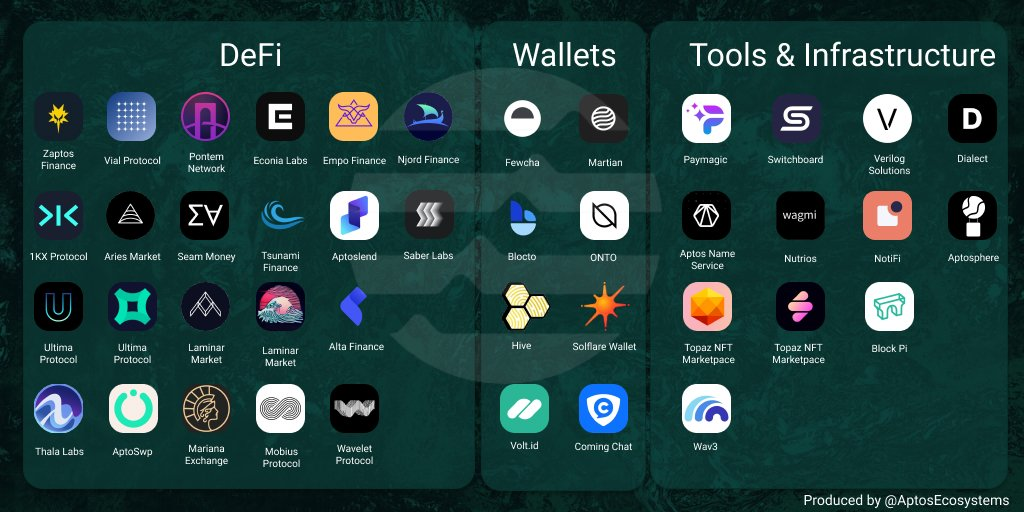
Sui
Sui’s ecosystem is still very new, the network is only in the DevNet stage, and there are not many projects announced to deploy on this network. However, it is not anything, there have been first projects appearing in different areas such as AMM, NFT, Wallet, and Infrastructure.
The ecosystem is still very young, not yet formed enough basic puzzle pieces. This can be explained by the formation and development later than Aptos, the Sui Move programming language is somewhat different from the original Move, making Sui pickier for developers.
In terms of ecosystem overview, Aptos is proving to be more dominant than Sui in terms of the number of projects as well as the completion of the overall picture. This shows that Aptos is getting more attention from the community, the larger ecosystem size will attract more users and increase competition in the system.
Although both ecosystems are actually at the devnet stage, not yet the mainnet, the complete ecosystem and a large number of projects are a plus point for Aptos.
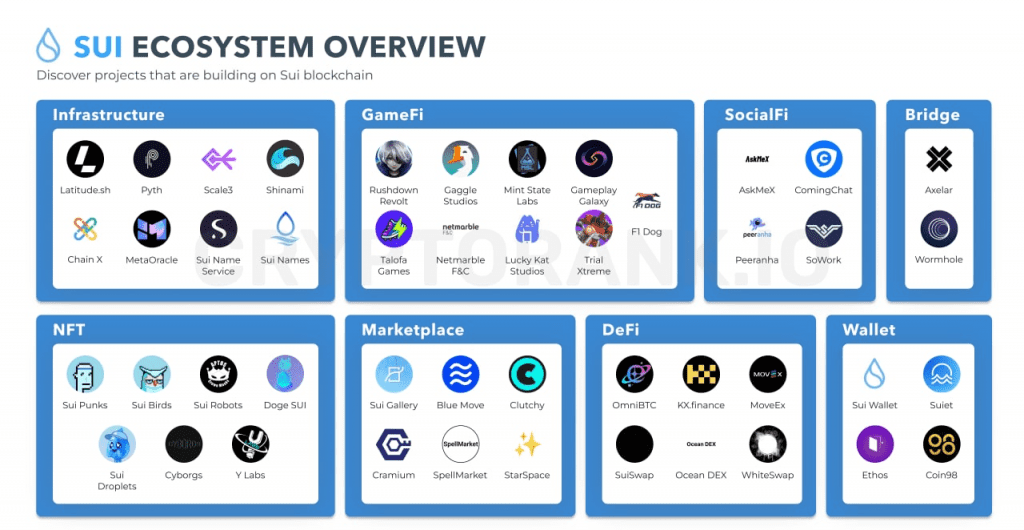
Summary
In general, these are two projects that have attracted the attention of the community due to their new technology and a huge amount of capital. To confirm which project is more potential at this stage is impossible because it is too early. However, at present, it can be seen that Aptos has a slight advantage over Sui due to its first formation and development, having the advantage of the community.
Find more information about:
Website:
Whitepaper:
https://github.com/MystenLabs/sui/blob/main/doc/paper/sui.pdf
https://aptos.dev/aptos-white-paper/aptos-white-paper-index/
Twitter:
https://twitter.com/mysten_labs
If you have any questions, comments, suggestions, or ideas about the project, please email ventures@coincu.com.
DISCLAIMER: The Information on this website is provided as general market commentary, and does not constitute investment advice. We encourage you to do your own research before investing.
Lucian
Coincu Ventures

















